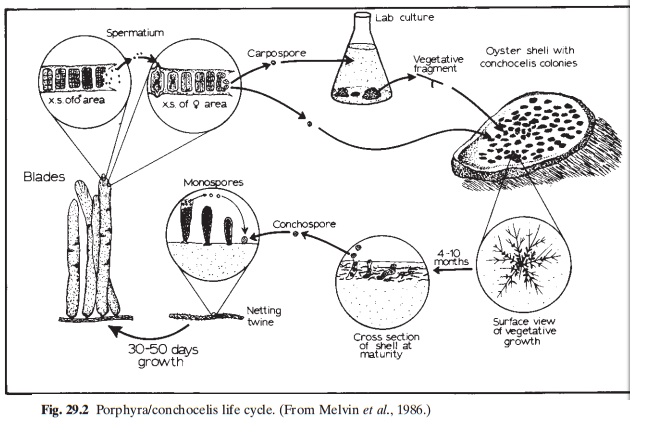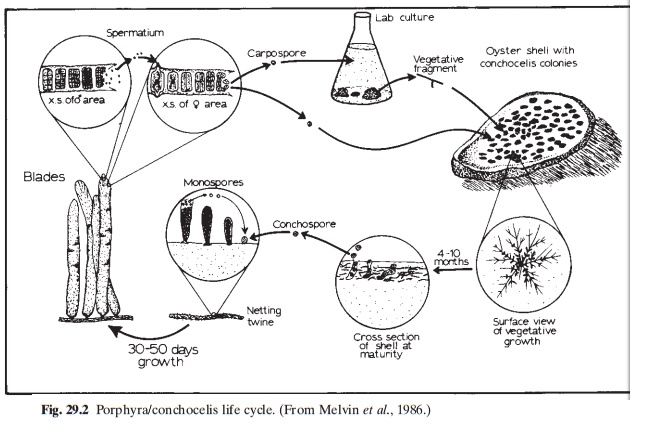Chapter: Aquaculture Principles and Practices: Seaweeds
Porphyra culture practices - Seaweeds

Porphyra culture
In terms of magnitude of production and the history of technological developments, the red alga, nori or amanore (Porphyra) is the most important among edible seaweeds in Japan. There are over 20 species of the genus, but only four species are actually cultivated to any appreciable extent. Porphyra tenera is the pre-dominant species, the others being P. angusta, P.kuniedai and P. yezoensis. Porphyra tenera isandrodioecious, P. kuniedai and P. yezoensis are monoecious and P. angusta is dioecious. The growth periods of P. tenera and P. angusta are relatively short and that of P. yezoensis is some-what long. The slowest growth is found in P.kuniedai. The species ofPorphyra cultivated inChina are mainly P. haitanensis in the southern part of the country and P. yezoensis in the north.
Culture using natural seedlings
The traditional system of catching monospores of Porphyra on bamboo or twigs of other trees is seldom practised now. Nets made of palm fibre or synthetic twine are laid flat at a suitable level below the sea surface, supported by a series of bamboo poles or wooden stakes driven into the seabed along the length of the net at intervals of 2.5–3m. Instead of nets, hibi (blinds) made of split bamboo tied together by ropes are also used in the same manner as nets. The size of these hibi in Japan varies with locality, but the common size is 18, 36 or 45m long and 1.2, 1.8 or 2.4m wide. To utilize deeper off-shore waters, floating systems consisting of syn thetic ropes supported by buoys and held by anchors are used.
The nets or hibi are spread to catch seed at different times and localities (usually in September and October), when the water temperature is about 22–23°C. The best catches are reported to be made on the second to the fourth day after the 1st or the 15th of the lunar month, or after a storm. Four or five hibi may be placed one over the other for spore collection.As in the case of molluscs, the areas suited for seed collection are not always the best sites for on-growing of nori. The spores are developed in areas of higher salinity near the open sea, but areas of lower salinity near river mouths are much more suitable for subsequent growth.
About a month after the hibi are spread, small buds can be observed on them and at this time they can be transplanted to the growing area. During the growing period, it may be necessary to adjust the level of the net or hibi according to the temperature and tide conditions and also considering possible exposure to diseases such as the fungus disease caused by Pythicum spp. At lower levels the nori growwell, but are more exposed to disease. By exposing them to air, fungal growth can be partially prevented, but overexposure may affect growth and toughen the thallus, reducing the value of the product. In about 50–60 days, the thalli grow and multiply in temperatures between 5 and 10°C. Lengths of about 15–20cm are considered a suitable size for harvest. Smaller ones are left for further growth. Harvesting can be done from the same substrate three or four times, and the final harvest contains plants of different sizes.
Controlled production of seedlings
Controlled production of seedlings is now widely practised by the use of conchocelis. After a period of active growth during winter months, the thalli of Porphyra become progressively reduced in size, and some of them develop carpogonia and others spermatia.

Sexual fusion between the contents of carpogonia and spermatia gives rise to carpospores. In summer the thalli disintegrate and the liberated carpospores sink to the seabed. They settle on mollusc shells and start germinating, giving rise to the microspic filamentous plant known as the conchocelis stage or the summer phase of Porphyra(fig. 29.2). The filaments burrow and grow beneath the surface of the shell substrate, eventually forming a darkly-stained area consisting of a plant mass on the shell surface. In autumn, when the water temperature drops and the photoperiod shortens, the spore-bearing branches or sporangia of the conchocelis mature and release non-motile monospores (conchospores). They are carried around by tidal currents until they attach them-selves to suitable substrates like rocks or, in culture situations, to nettings or hibi spread out to catch them. The cultivated species of Porphyra reproduce asexually as well, and theyoung plants release monospores.
Taking advantage of the above described patterns of reproduction, it is now possible to produce seed indoors in open containers. At the end of the growing season (February to early April) ripe Porphyra leaves with well-developed sporangia along the margins are collected and placed in containers of about 20l capacity, filled with sea water. To stimulate the release of spores, the leaves are lightly squeezed and within a few minutes the carpospores can be observed on the water surface. Other methods of obtaining carpospores are also employed. Parent thalli, dried overnight and immersed in sea water for four to five hours, will induce spore formation. An alternative is to use pulverized thalli in sea water, filtered to produce a carpospore suspension. To set the spores, clean oyster shells are placed in shallow concrete tanks with the inner side up. Water containing carpospores is then evenly poured over the shells. About 20000 shells are needed to set the spores from about 1kg mature leaves. At temperatures of about 10–15°C, the car-pospores germinate and burrow into the shells. According to Saito (1979), transparent vinyl films covered with calcite granules are now used as a substitute for shells.
For proper growth of conchocelis the shells are strung on nylon cords after seeding and suspended in large sea-water tanks (2 x 3 x 0.7m) placed indoors with a suitable means to control sunlight. The strings of shells are suspended from bamboo sticks in such a way that each shell is freely bathed in sea water. The temperature is maintained around 23–25°C and the light intensity at 500lux or less to prevent premature liberation of spores. By manipulation of the temperature and light intensity, the time ofmaturation of the spores can be varied to meet the requirements of farming. The nutrients in the water and the substrate are usually enough for the growth of the algae, but the addition of small doses of phosphate and nitrogen fertilizers improves the rate of development. The water in the tanks is renewed only if its quality deteriorates. The shells remain in the tanks for about five months and, with adequate growth, the algae become visible to the naked eye as greyish-purple spots. If the shells are overgrown with diatoms or other organisms they can be brushed clean, as the conchocelis is safe inside the shell material. By about September or October the conchocelis have their sporangia well developed. When the temperature falls below 22°C and the days are shorter, maturation becomes rapid and the release of spores occurs.
A system for the production of free-living conchocelis, without any substrate, has been developed. Mature thalli are kept in containers with enriched sea water for the release of car-pospores. The carpospores grow into globular colonies on the bottom of the containers in about two months. These colonies are divided into smaller portions and transferred to other containers and cultured in aerated sea water. As the colonies grow in size, they are again divided and transferred to new containers and the process repeated several times. Thus a large number of free-living conchocelis are produced and the culture is maintained for a long time with temperatures ranging from 24 to 28°C and 750lux illumination for eight hours a day. The conchospores are released by cutting the conchocelis into small pieces to enable seeding of the shell substrates.
To seed the hibi (nets, blinds or ropes), several methods are employed, but the basic requirement is to ensure maximum exposure to the hibi substrate and to keep the spores in motion to facilitate contact with it. This can be done on shore or in the sea. By immersing the hibi in conchocelis culture tanks for a few minutes, enough spores can be collected. Spore collection on nets is made easier by rolling them on rotating drums fitted above the tanks (fig. 29.3). A number of nets are rolled around a drum which is slowly rotated to immerse the nets in the tank, so the spores can settle on them. Single or double drums can be used. The settling of spores can also be facilitated by creating a curtain of air bubbles from pipes placed at the bottom of the tank.The nets are stretched horizontally below the surface, and the air bubbles drive the spores towards the net.

For seeding at sea, nets or bamboo blinds are stretched between poles in areas which are not exposed at low tide. Vinyl bags containing the conchocelis-bearing shells are hung under the nets or blinds. The spores, when released, settle on the substrates. This type of seeding allows proper regulation of spore density on the substrate and protects from adverse weather conditions.
Another method of seeding hibi in the sea is by spreading conchocelis-bearing shells in the intertidal seabed and placing five or six layers of hibi on top of them. In a couple of days the spores will have settled on the hibi, which can be transferred to racks for rearing.
Although the seeded hibi are generally used immediately for on-growing, they can be kept if necessary for several weeks in a cold store, covered with polyethylene sheets to keep them moist. Porphyra buds can also be stored for over six months by first drying them to bring the moisture content down to 20–30 per cent and then packing them in polyethylene bags for storage at -20°C. This helps to make seeded hibi available for replacing the old ones which have ceased to be productive.
Grow-out of conchocelis seedlings
The grow-out procedures for conchocelis-derived seedlings are essentially the same as for natural seedlings. In about 50 days after germination the plants grow to lengths of 15–20cm and harvesting is then started (otherwise the plants are torn off by waves). Subsequent harvests are carried out at 15–20 day intervals. After repeated harvesting, when the size and quantity of thalli on the hibi decrease, they can be replaced with new ones stored under refrigeration. In areas where the nutrients are scarce or depleted, the cultivating grounds are fertilized to improve harvest. Fertilizer pellets containing about 90 per cent nitrogen and 10 per cent potassium are suspended from porous containers to last for about a fortnight at a time. Fertilization is also adopted in some areas just before harvesting to improve the colour of the product. Diseases associated with poor weather
Methods of processing Porphyra have been described. The drying of the thalli has to be carried out within two to three hours at a temperature below 50°C, to enhance the gloss, taste and flavour of the product.
Related Topics